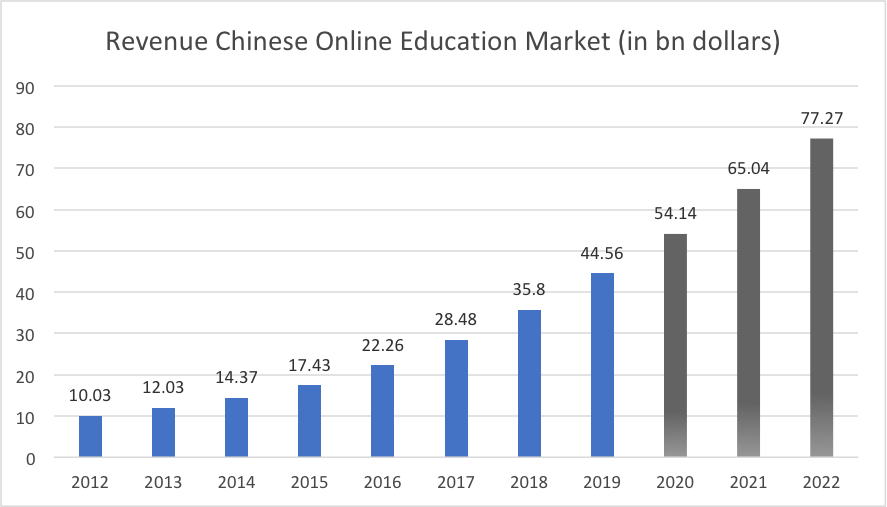- China’s digital education market has experienced substantial growth in the past and is bound to become even more important in the future. This is due to several factors: 1) A growing online population predicted to reach 975 million in 2023 2) An additional boost to digital education due to COVID-2019 3) A growing Chinese middle class with higher spending power 4) A hyper-competitive education system incentivising investment in extracurricular activities 5) Unprecedented changes due to automation encouraging lifelong learning 6) Continued government investment in the sector
A glance at some figures illustrates how successful the Chinese digital education market has been – and that it was thriving well before the pandemic. According to the consultancy firm iResearch the market had reached USD 36 billion by the end of 2018, having experienced a consistent year-on-year growth of about 25% since 2012. In other words, the digital education market has more than tripled in just seven years. Chinese people have certainly warmed to digital education. A report by the China Internet Network Information Center states that the number of users has reached USD 232 million by June 2019 – up 31 million compared to the end of 2018. It is no surprise then that eight out of the world’s 15 largest digital education companies are based in China. Prominent examples include VIPKid, which offers one-on-one English classes with teachers in North America; Liulishuo, a startup investing heavily into AI driven education; and New Oriental, currently the largest private education company in China.

Source: iResearch Consulting group.
Lately, digital education has received an additional boost as authorities have been trying to curb the impacts of the pandemic. Addressing the need for continued learning despite closed schools, China’s Ministry of Education (MOE) requested all local schools to provide digital education, thus further vitalising this sector. A government official commented: “Whilst classes may be suspended, there is no reason to suspend teaching or learning. Accordingly, a “National Online Cloud Classroom” opened its ‘doors’ on the 17th of February, effectively taking the place of traditional brick-and-mortar classrooms for first to twelve graders. In the whole of China 200 million children – 25 times the population of Switzerland – have gone back to school by taking classes online, thus further pushing and normalising the use of online resources for educational purposes.
Digital and traditional education aren’t mutually exclusive
There is no denying that digital education comes with its challenges. Some teachers argue that it is hard to reach a similar level of engagement with the class through online teaching. Sitting in front of the computer might not establish the same teacher-student connection as sharing a physical classroom with him or her. Also, interactions between students are limited, not only during class, but also during breaks and afterwards. Studies have suggested that students learn a lot when they interact with each other without receiving instructions by an authority figure. It might prove difficult – though by no means impossible – to facilitate what is called ´peer learning´ online. Another challenge is the lack of pressure when not everybody around the student is scribbling notes in their notebooks (or when said student cannot see his peers scribbling notes in their notebooks). It might be more of a temptation then to let loose and give oneself a break, since such behaviour does not immediately stand out in one’s environment.
Having said that, digital education doesn’t have to replace traditional ways of studying. The two can easily coexist and complement each other. In fact, many Chinese education companies implement a mixed approach, using both online and offline education at the same time. According to Deloitte the so called ´double teacher method´ was the most popular in 2017, involving an online teacher addressing students via video broadcast as well as a teaching assistant instructing them in person. Moreover, there are inherent advantages of digital education. Quality of instruction in China varies, with rural areas lagging behind bigger cities, suffering from overcrowded classes and subpar teachers. Digital education can create a more even playing field by providing these areas with access to the country’s best teachers and even to native English speakers from abroad. Further, digital education companies are not dependent on big teaching facilities, which is particularly advantageous considering some of China’s property prices. Being able to create and duplicate virtual classrooms from everywhere simply saves a lot rent. Last but not least, digital education frees up a tremendous amount of time. Being accessible from any place with an internet connection (or simply via smartphone) the need for commutes to specific teaching facilities is effectively done away with.
Digital education is bound to grow
One of the most pivotal moments in every Chinese student’s life is the so called Gaokao (literally ‘high test’), an academic examination which lasts about nine hours, split up into two or three days. Getting a high exam score means gaining access to the most prestigious universities in the country. However, in order to enter the ´promised land´ Chinese pupils have to outcompete a myriad of other candidates. Roughly 10 million take the exam every year, but the so called C9 universities – China’s ´Ivy League´ consisting of the nine most reputable universities in the country – only accept 50’000 students, which amounts to a mere 0.5 percent of candidates. Given this hyper-competitive landscape, many parents are willing – and indeed feel forced to – invest in extracurricular education. Here digital education comes in, allowing children to gain an edge.
Playing into that dynamic is the growing middle class of China and thus the ability of an increasing amount of people to spend more and more on education. GDP per capita skyrocketed from USD 156 in 1978 to roughly USD 10,000 in 2018. In accordance with this development, China’s middle class has experienced massive growth over the last years, no matter which definition of middle class one wants to apply (there isn’t a standard definition for the term). China’s statistics agency puts the number at around 400 million, which, though huge in absolute terms, is still less than a third of the country. The growth potential becomes apparent when one compares this number to other countries – the middle class in the US comprises more than 50% of the population, in South Korea it makes up 65%. A study by Bain & Company indicates that China’s middle class will continue to expand in the new decade and eventually encompass 65% of all households. Moreover, according to this consultancy firm, household consumption will grow an impressive 6% each year. A study by McKinsey points in a similar direction, predicting that more than 75% of China’s urban population will earn between USD 9000 and USD 34,000 a year by 2022. Knowing that Chinese parents put education first and foremost, these numbers shed light on why digital education is likely to become even more important in the future.
Moreover, the market is by no means limited to preschool or K12 education, but also includes adult education. A term often mentioned in this context is ‘middle-class anxiety’, the fear of being left behind in an ever faster changing world. A natural strategy to adopt then is life-long learning, constantly updating one’s knowledge in order to keep up and stay relevant in the job market. The appeal of adult online learning is reflected in age related user numbers. In the case of Liulishuo, an AI-powered app giving users real-time feedback on their English pronunciation, adult customers make up 45% of the user base compared to only 30% of younger customers. Apps like Liulishuo can be used sporadically throughout the day and are geared towards people with busy schedules, i.e. white-collar workers.
Lifelong learning becomes increasingly important
In an age where automation threatens to not only disrupt low-income sectors, but also white-collar workers such as accountants, wealth advisors, traders and even fashion designers the pressure is high to stay ahead of the curve. McKinsey estimates that 60% of all occupations can at least be partially automated based on currently available technology. The consulting firm predicts that automation will affect 50% of all work activities in the next two decades. According to McKinsey, these changes will occur even faster if no measures such as regulatory restrictions are taken. Suffice it to say, automation will trigger change on an unprecedented scale, especially in a country eager to adopt the latest technologies as fast as possible. The pressure to keep on learning after one’s formal education will thus increase in the future, and with it the need for additional educational resources.
Not surprisingly then, the Chinese consulting company iResearch predicts a massive expansion of the digital education industry, expecting an annual growth of 16% to 25%. This would translate to a doubling of the current market volume in three to five years, putting it at USD 77 billion. Meanwhile the Chinese online population is predicted to go up as well – by a staggering 100 million people to reach 975 million users in 2023. Since it is estimated that digital education comprises less than 10% of the current education market, there is growth potential in terms of market share as well. Moreover, China has shown a willingness to fuel that growth. It leads the world when it comes to funding for education innovation and technology investment; in 2018 China outspent the USA roughly by three to one, leaving their closest competitor far behind. According to the Minister of Education, Chen Baosheng, China will continue to invest in artificial intelligence to improve education and has already issued plans to achieve that goal.
To summarise, the continued growth and spending power of China’s middle class, the expansion of digital education in the wake of the COVID-19 epidemic, the hyper-competitive landscape incentivising extracurricular K12 education, the age of automation and the pressure for life-long learning, as well as the growing Chinese online population and their ´online first´ mentality, provide strong indications that digital education will continue to thrive in the future.






NO COMMENT